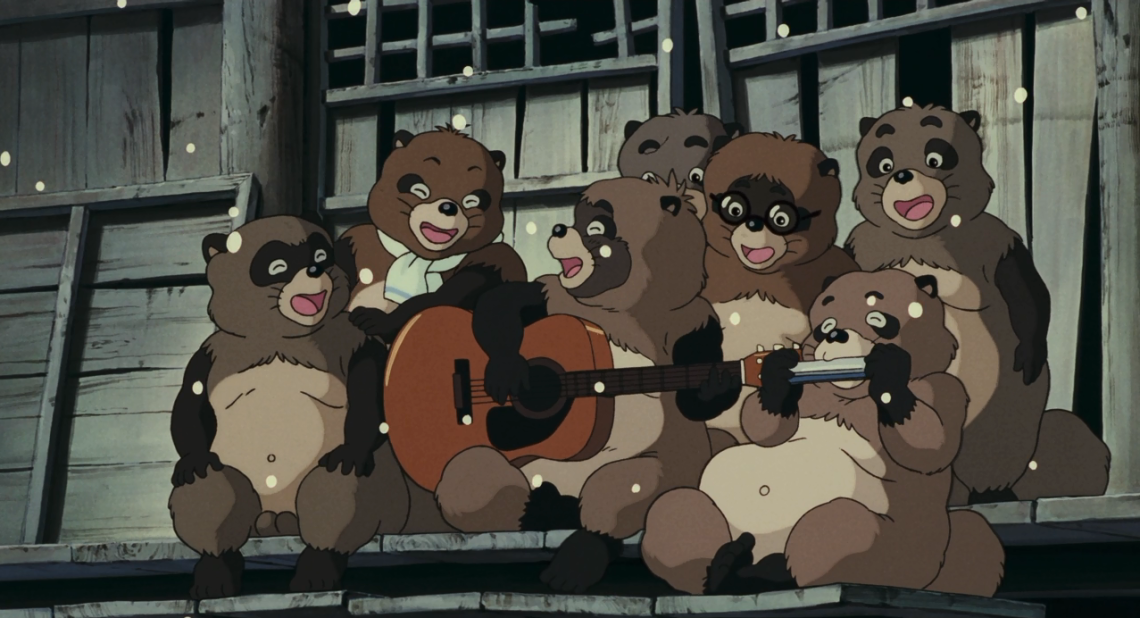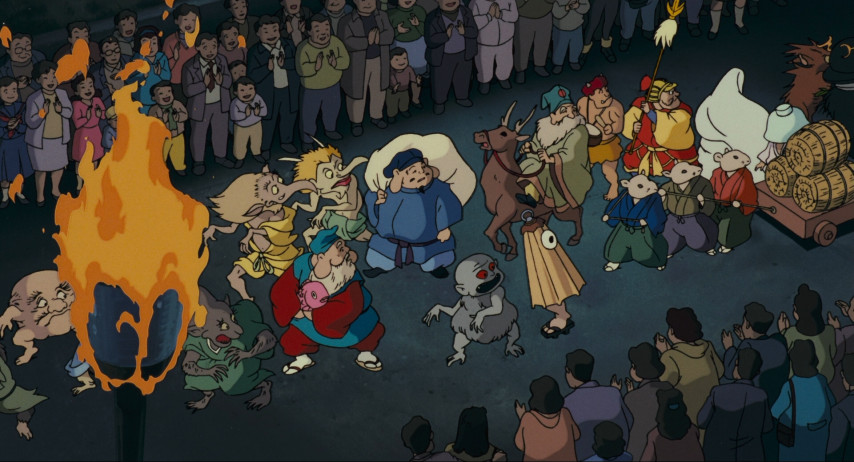I'll get it out of the way now.
This is the Studio Ghibli film in which magical, shape-shifting racoons use their testicles as weapons.
And you thought Rocket Racoon was dirty...
Now this is maybe crude, a bit insensitive and a way to draw my readers in but I think it's a good place to start when exploring the transnational nature of Pom Poko, Isao Takahata's third film for Studio Ghibli. So a bit of context is needed, I think, on the tanuki. Tanuki are in fact real canine animals native to Japan. Japan places an interesting emphasis on mythological creatures called yokai. These are essentially a collection of animals or demons who share magical properties. The fox is a famous example of this - this creature pops up all over Japanese mythology as sly, intelligent and came complete with shape-shifting abilities. However, by the 16th century foxes fell out of style with Japanese artists and began to focus instead on the loveable tanuki, imbuing them with some fox attributes, mostly the shape-shifting and the sneaky, mis-chief maker side. However, over the years, new attributes were added, such as laziness, eating, belly drumming and .. giant testicles. Tanuki went on to have an interesting design change over the decades but eventually became known as being fat and silly looking, leaving behind the mischievous nature of their past. And their exploits and general charm continue to delight Japan to this day. Tanuki statues are everywhere in Japan. The point of this is that tanuki are big in Japan, bigger than big - they're an everyday part of the greater pop cultural psyche. Think of them being like fairies for western children. In this regard, I think Pom Poko, from a Western perspective, is very hard to gauge with. Magical testicles is just a standard part of tanuki myths for Japanese audiences, so it should come as no surprise that this is a big plot point of Pom Poko - for a Western audience, on the other hand, this a major talking point of the film and often how conversations about it start!
 |
| Pom Poko, while having several good elements, ultimately becomes a bit of a bore |
 |
| A good example of modern tanuki, which can be found all over Japan |
I like to use Pom Poko as an example of how reception to a film can change according to the country and broader cultural context. To be honest, I find this element much more interesting than the film itself. Unfortunately, like Ocean Waves, I find Pom Poko to be a bit under-whelming. Overall, I prefer it to Ocean Waves, due to some great creativity and genuinely excellent scenes, but the choices on how to tell the story are genuinely baffling to me. Takahata uses this story as a springboard to explore the theme of the price of progress against the cost of nature, a recurrent theme for Ghibli but does little in terms of character or narrative.
Pom Poko follows the plight of a tribe of tanuki living near Tokyo. They enjoy a lazy lifestyle in the pristine countryside. However, disaster strikes when construction men begin to dig up their homes in the forest to make way for a large urban development project. The tanuki band together to formulate a long term plan on how to stop the humans. This includes re-learning how to shape-shift (a key aspect of the mythology and a sign of how lazy the tanuki have become) and seek the ancient masters, scattered across Japan, to help them in their time of need. However, idealogical difference begin to spring up between the tanuki as the ticking time bomb to save their homes and life-style edges closer and closer.
 |
| Pom Poko has characters ... I think? |
So the film's biggest problem is how the story is told. While there's a lot I like about the film, which mostly comes in the final act, the proceeding time is plodding and mostly directionless. Instead of having a firm central character, we continually shift to different perspectives with little time given to establish their personalities outside of a one-note character motif. This style can work. I recently saw the sweet Wonder, which shifts between multiple different characters to understand how they feel and interact with the film's main character. It's well done and works, due to the story being relatively small-scale. Pom Poko's stakes are higher, with the whole of the tanuki's homes at risk of being demolished. The lack of central character really harms this for me. The narrator as well doesn't really do much for me either. Instead of experiencing character motive, we are simply told that a character feels this way before dropping us into their situation and are then expected to care. Unfortunately, this mentality makes up most of the film. I think it's meant to evoke a historical document to give added weight to the proceedings but it just ends up making the narrative a bit dull. We see the tanuki taught by the elders of the tribe to re-connect with their shape-shifting powers and the early attempts to sway humans to their side (through violent means, which can only be described as ecological terrorism). They also send a couple of tanuki on a heroic quest to track the old masters, now scattered across Japan, to help them in their plight. And, yes, the men are also taught how to use their ball sacks as weapons.... We do have a handful of characters to follow - the bland Shoukichi, the hot-headed Gonta .... that older woman tanuki? ....Shokichi's friend? ...oh and his partner...? Then there's that one with scarf.... .... The fact is this - I've had to look up the character names on Wikipedia, even though I've seen this film three times now...The training of the tanuki makes up a huge chunk of the film and with no interesting characters to latch onto, it makes the whole thing a bit of a bore. The only enjoyable element is the animation, particularly when they begin to mimic humans. Oh, and I love their addiction to watching TV, which distracts from their training.
Now, that said, some elements of the film really works for me. The parade that the tanuki perform through the streets of Tokyo, to scare the residents at large to re-think the urban development plans, is a wonderful sequence and brilliantly animated. Every character from Japanese mythology can think of is here and it is a genuinely fun sequence. Now from a Japanese perspective, the illusions here are probably very recognisable from the lessons taught in primary school but to a Western audience, the scene is exotic and very strange. See that transnational element popping up again. Keep an eye out for cameos from Totoro, Porco and Kiki as well. I love that the residents completely mis-interpret the parade and a huge corporation claim it as their own publicity stunt, completely undermining the tanuki's intent. I love the sense that, despite everything they do, there is simply no stopping human progress. An interesting element crops up in the second half when the tanuki learn that fellow mystical creatures, the foxes (also shape-shifters) have integrated into human society, now working as sneaky and manipulative businessmen (perfect for the infamous creature as represented in Japanese folklore). Could this be a way out for tanuki?
 |
| Despite major problems with the problems, Pom Poko has several excellent individual sequences and a nuanced, bittersweet message about preservation of the natural world |
The end is pitch perfect. After fighting and fighting for the whole film, the tanuki ultimately can't stop the urban development. Many of their comrades have died and all hope is lost. I love the scene of the one tanuki, who comes back after years of searching for one of the old masters, finds his home completely destroyed and changed. A beautiful sequence sees all the remaining tanuki come together to perform one last grand illusion, temporarily restoring the urbanised area back to it original state, to remind humans of what has been lost. However, I like the film's message that life must move on, in a bittersweet way. Some tanuki use their skills like the foxes and blend into society as normal humans. The ones who can't shape shift struggle to adapt but continue to eke out a form of living for themselves. The urban development does take into account the environmental and ecological issues that the tanuki's actions invariably brought up and turn parts of it into a sustainable green park. However, these areas are simply too small for them, so many have to leave to find new homes out in the further parts of the country. Honestly, it's a touching and well-made coda that I wish I cared about more. The points are considered and offer a balanced portrayal of the fate of the tanuki, urban development and human caused extinction...until one of the characters literally turns and talks to the camera about the importance of looking after animals and their environment...You know, we've not touched upon this yet but I really do love the way Ghibli subtlety weaves the environmental messages of their films into the narratives and doesn't hit you over the head with it ... this moment is particularly egregious because the 10 minutes before do offer a fairly nuanced take on the effects of interfering with an ecosystem, both the positives and the negatives... so this part where a character directly talks to the audience is just heavy-handed, out of place and ends the film on a sour note.
I will give Pom Poko this though - as opposed to Western ecologically heavy films, such as Ferngully, the film does not paint the humans as being the manifestation of pure evil. Just mis-informed, unaware and ill-educated. This is a good addition.
 |
| There's a great film in Pom Poko but it's far from being a classic Ghibli |
Pom Poko is a film I severely wish I could like more. I do think there's a great film in there, as evidenced by the parade and ending coda sequences. However, the decision to continually shift the perspectives means that it's hard to get a grasp on the individuals characters. This film really could have done with a central focus - a firm character that the audience follows which would then work as a springboard to explore the other personalities of the tribe. There is creativity abound in the film, especially for a Western audience new to this material. While this is fairly standard primary school stuff for a Japanese audience, Pom Poko does offer an entry way for Western audiences to engage with wider Japanese mythology. All that said though, Pom Poko just ends up feeling over long and plain dull in some parts. A few great sequences aside and some wonderful animation can't make up for a lacking script.
Next time, we get out of the mini-Ghibli rut of the early 90s with a really good one - Whisper of the Heart. Country roads, take me home ...
Serious props to this YouTuber for his excellent video about the history and legacy of tanuki! He even explains just what the deal is with the tanuki scrotum thing... I learned a lot!
https://www.youtube.com/watch?v=icyOAc_pAvY
The English dub ... is completely forgettable. I've seen it once a long time ago and it left no mark on me whatsoever. You've got J.K. Simmons in there and the always awesome Tress MacNeille. Weirdly it also has Jonathan Taylor Thomas, who is probably most famous as the voice of Young Simba in The Lion King.


No comments:
Post a Comment